Becoming Iron Man: A Dream Within Reach at Just $999
![]() 08/27 2025
08/27 2025
![]() 569
569
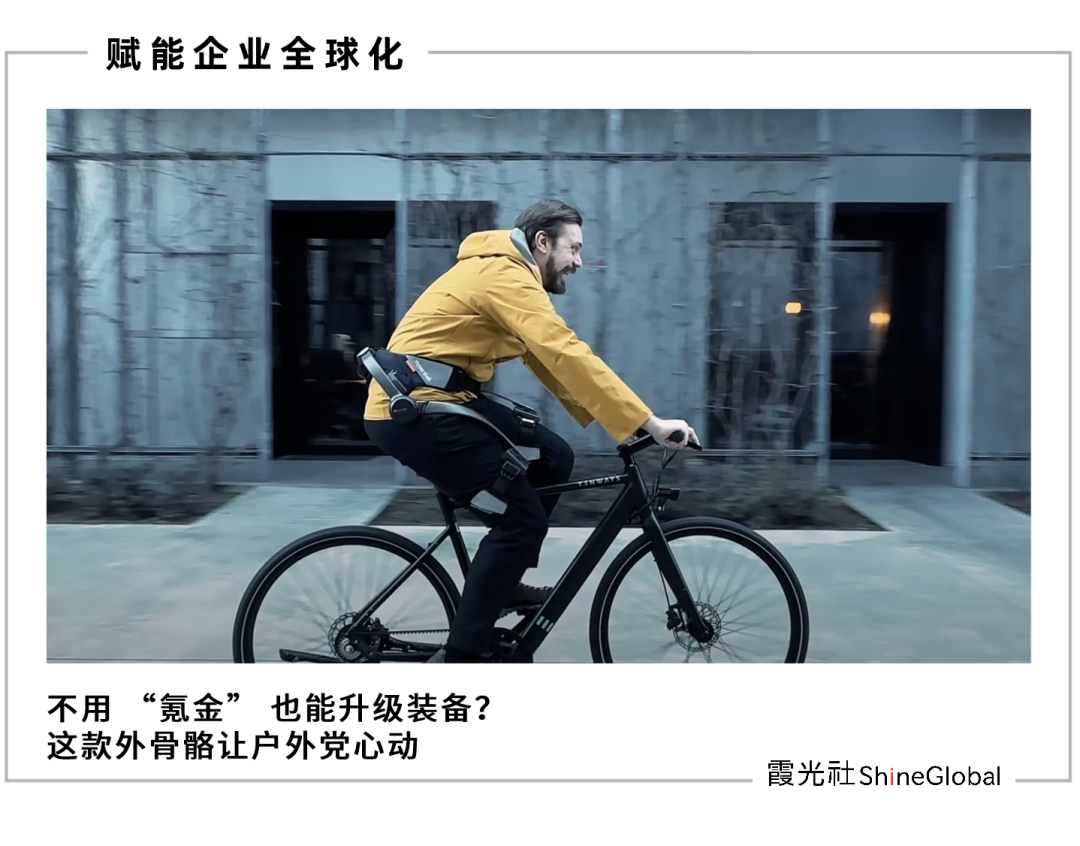
Author | Lingnan Mermaid Machine
Editor | Li Xiaotian
Editor's Note:
From overseas expansion to diving into the deep seas, and eventually becoming a global enterprise, more companies are stepping into the limelight with an outward-looking mindset. Ideally, they possess the DNA of Chinese enterprises combined with a global vision. However, this journey is never a smooth ride to financial success. The path to brand globalization not only tests the reach of products but also the resilience and judgment of enterprises amidst the treacherous geopolitical landscape.
As going further becomes the main theme, how will the world welcome these new entrants? A new business competition has commenced, and Xia Guang She proudly launches the "Shine Brand" column to provide insights into the opportunities of the times and inspiration for global players and industries from a micro perspective on brand growth.
This is the fourth issue of the column - "Hypershell," the world's pioneer in bringing mechanical exoskeleton products from the medical and industrial realms to the consumer market. In 2023, Hypershell launched the world's first consumer-grade exoskeleton product, "Hypershell Go," on Kickstarter, raising over $1.2 million in crowdfunding and becoming the 2023 Kickstarter Best Seller. Earlier this year, Hypershell's inaugural product was officially launched overseas, boasting over 10,000 users worldwide.
If you were to unleash your imagination, how could humans continuously push the boundaries of their capabilities?
Science fiction movies often take our imaginations to extremes, whether it's through the exhaustive development of the brain, extending from the mental realm to the physical body, and driving the shell with thought, as Musk firmly believes in human-computer interaction; or by utilizing external forces, such as a superman shield, mechanical arms, or golden armor, to maximize equipment potential.
In reality, humans often channel their desire to explore the physical world into nature. Treading the land with our feet and traversing mountains, rivers, and jungles offers both the thrill of adventure and a sense of vastness for body and mind. As a result, more urban dwellers have started wandering in the mountains and fields. In the domestic market, according to the "2024 Online Consumption Development Report on Outdoor Sports," in 2024, the number of online consumers of outdoor sports in China is expected to reach approximately 200 million, with total consumption exceeding 300 billion yuan.
To excel, one must first have the right tools. More supplements for outdoor equipment have become a necessity for outdoor enthusiasts, who continuously invest in them. However, the journey is fraught with challenges. For instance, eco-tourists, outdoor photographers, hunters, and others often need to carry loads exceeding 10kg and walk for several hours on undulating mountains to complete their tasks or journeys. Occasionally, difficulties arise during mountain climbing, forcing individuals to abandon their endeavors or seek assistance.
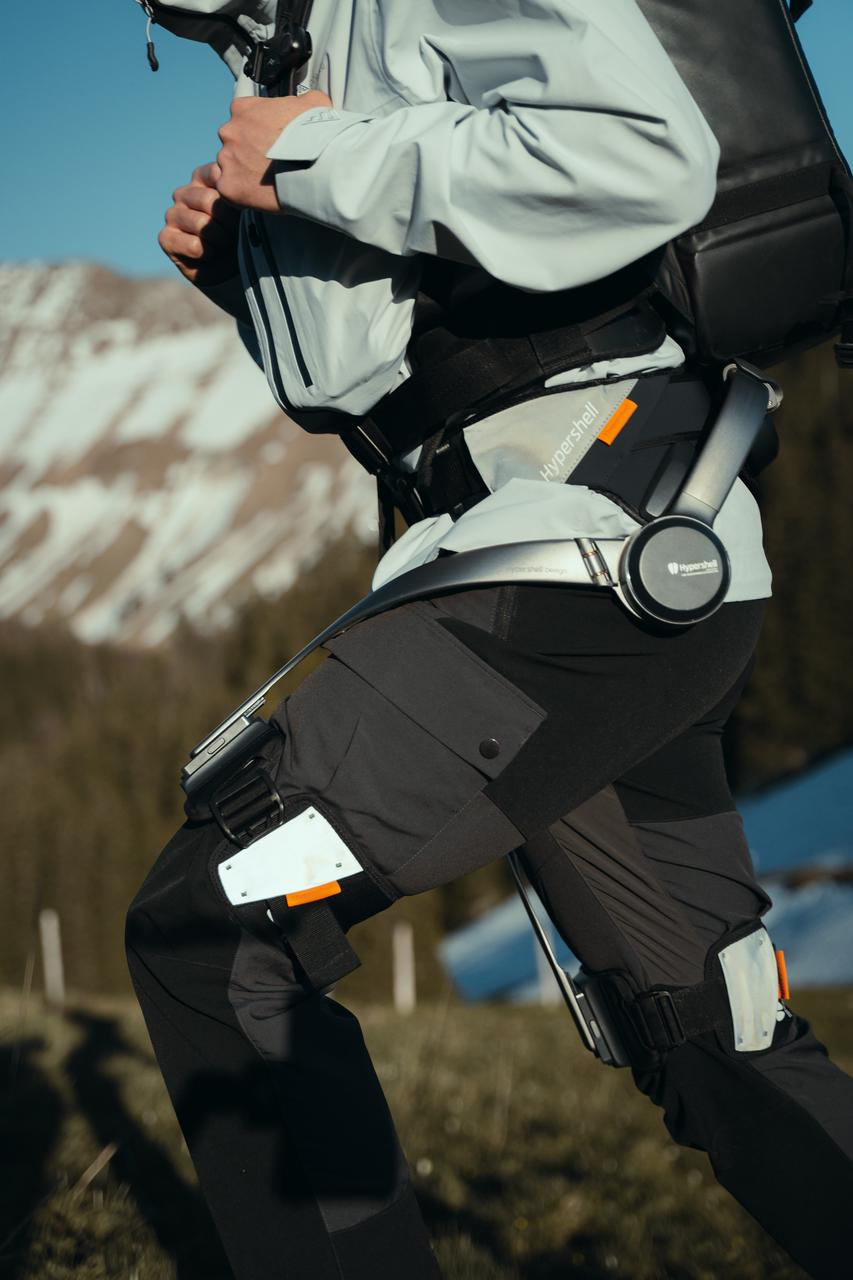
Traditional outdoor equipment fails to help people transcend their physical limits, but earlier this year, exoskeletons emerged as a new type of outdoor equipment in domestic scenic spots, aiding tourists in enjoying their visits more effortlessly. Currently, this innovative climbing aid can be seen in numerous renowned scenic spots such as Changbai Mountain, Huangshan Mountain, Qingcheng Mountain, Huashan Mountain, and Wugong Mountain. Previously, exoskeletons, which were solely used in medical and industrial fields, have now begun to capture the broader public's attention.
Hypershell was founded at the end of 2021 with the aspiration of bringing exoskeleton devices previously utilized in military, medical, industrial, and other fields into the consumer market. It targets overseas outdoor enthusiasts (such as explorers, photographers, etc.) as an entry point, and consumer-grade exoskeletons can be utilized for mountain climbing, long-distance running, cycling, and other sports. In these scenarios, Hypershell offers users a lightweight and intelligent outdoor experience. For innovative smart hardware products like exoskeletons, is it still feasible for niche scenarios and small incisions to yield significant individual product success? What new visions does moving towards the consumer-grade field entail? We will gain some insights in this article.

What is an Exoskeleton?
In simple terms, an exoskeleton is a wearable intelligent mechanical device inspired by biology. Early on, people were inspired by beetles and attempted to invent mechanical devices made of steel frames that could be worn by humans. Through the collaboration of motors, sensors, control systems, and other technologies, this mechanical exoskeleton, often referred to as a "powered exoskeleton," is essentially a wearable robot.
The ultimate form can be likened to the omnipotent iron suit in "Iron Man," where every part of the body is equipped with "new kinetic energy."
However, previously, exoskeleton robots were exclusively used in industrial, military, and other fields. Hypershell is the world's first company to introduce mechanical exoskeleton products from the medical and industrial fields to the consumer market.
In 2023, Hypershell launched the world's first consumer-grade exoskeleton, "Hypershell Go X," with a crowdfunding price of only $299. After its launch on overseas crowdfunding platforms Kickstarter and Indiegogo, Hypershell sold over 3,000 units in just one month. For comparison, before Hypershell reached 3,000 units through crowdfunding, as of 2021, the annual global exoskeleton shipment was only around 3,000 units.
Unlike outdoor sports, which have gradually gained popularity in China in recent years due to climatic and geographical conditions, outdoor sports have always been an integral part of the lives of Europeans and Americans.
Outdoor sports were first defined in Europe and the United States, generally falling under the categories of military and survival. In the United States, the early outdoor culture is deeply intertwined with the military. The United States is a country founded through resistance to colonialism, and the adventurous and combative spirit ingrained in Americans has fostered characteristics of "exploration," "hardcore," and "wilderness survival" in American outdoor activities.
For Europeans, whether it's casually cycling on weekends or taking a long walk in the forest, "outdoor sports" is a way of life, not just a form of exercise. The goal of outdoor sports is not necessarily to achieve muscular and slender bodies but to stay active and maintain health and balance. Therefore, what Europeans and Americans value in "outdoors" is the opportunity to see broader landscapes and climb higher mountains.

According to the "2024 Outdoor Participation Trends Report" released by the Outdoor Industry Association of the United States, in 2023, the number of Americans participating in outdoor recreation activities reached a record high of 175.8 million, accounting for 57.3% of the population aged 6 and above, an increase of 4.1% from the previous year. Among them, the participation rate of Americans aged 55 to 64 will rise from 41.2% in 2019 to 49.7% in 2023; the participation rate of Americans aged 65 and above will rise from 28.8% in 2019 to 39.5% in 2023. This data also underscores the high penetration rate and broad audience for outdoor sports in the United States, which translates to increased demand for outdoor equipment.
Currently, Hypershell offers three products: the basic Hypershell Go X, the more powerful Hypershell Pro X, and the Hypershell Carbon X. The differences lie in materials and power. Previously, Arc'teryx also produced consumer-grade wearable exoskeletons for outdoor climbers, but the Arc'teryx MO/GO, which began accepting pre-orders last year, is not expected to ship until October this year; in terms of price, the cheapest early bird pre-sale price is $4,500 (equivalent to RMB 33,000), and even renting it for 8 hours to experience it costs nearly RMB 600. The highest-end product of Hypershell is only about half the price of Arc'teryx and has already started shipping to users.
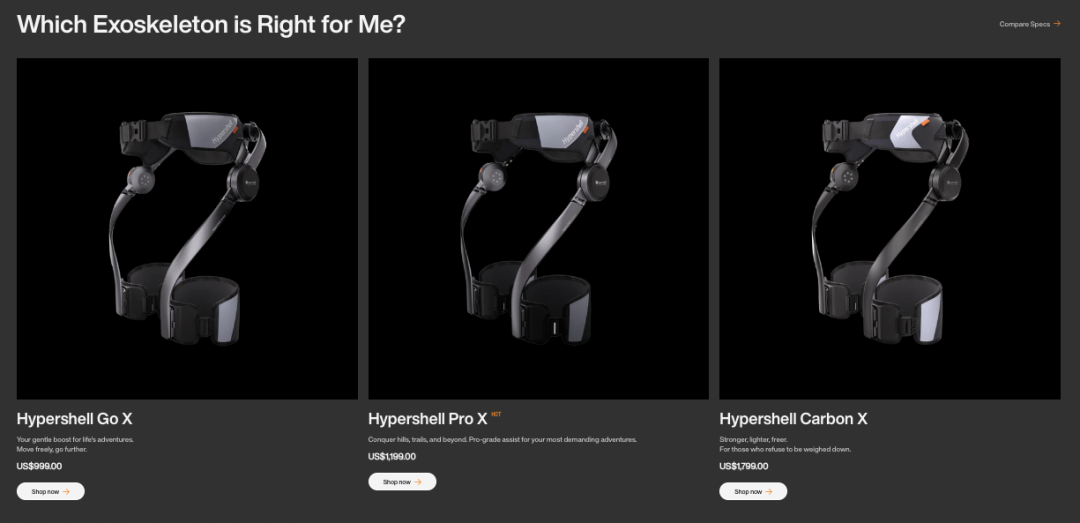

The higher compatibility of outdoor scenarios with the European and American markets is one of the reasons for Hypershell's exceptional overseas crowdfunding results. Additionally, the product strength of Hypershell is sufficient to impress the market, which is another factor contributing to its popularity among consumers.
Exoskeletons are not a "new thing." If we trace back, the origin of exoskeleton robots can be traced back to the 18th century. The early prototype structure of exoskeletons was relatively simple, primarily using cumbersome metal frames and basic mechanical transmission devices. While they could provide certain power assistance, due to technical limitations, they had numerous issues.
It wasn't until the 1960s that the first "mobile machine" truly integrated with human movement emerged - the Hardiman armor, jointly developed by General Electric and the US Armed Forces. This armor contains over 30 joints, driven by a hydraulic electric servo system, which can enhance the wearer's strength by 25 times, making it as easy to lift a 110kg object as it is to lift a 4.5kg object. This is the rationale and significance behind the need and development of exoskeleton robots for humans.
However, the Hardiman armor had significant limitations. Its immense weight of 680kg and outdated transmission structure greatly hindered the practical use of the device, ultimately leading to the project's failure.
By the 21st century, exoskeleton robots offered more than just superhuman strength: Lian Jye Su, research director at global technology intelligence company ABI Research, stated that the industry is expected to soar from $68 million in 2014 to $7.3 billion by 2030. In the future, with the expansion of application scenarios and technological advancements, the market size is anticipated to further expand, potentially exceeding 100 billion.
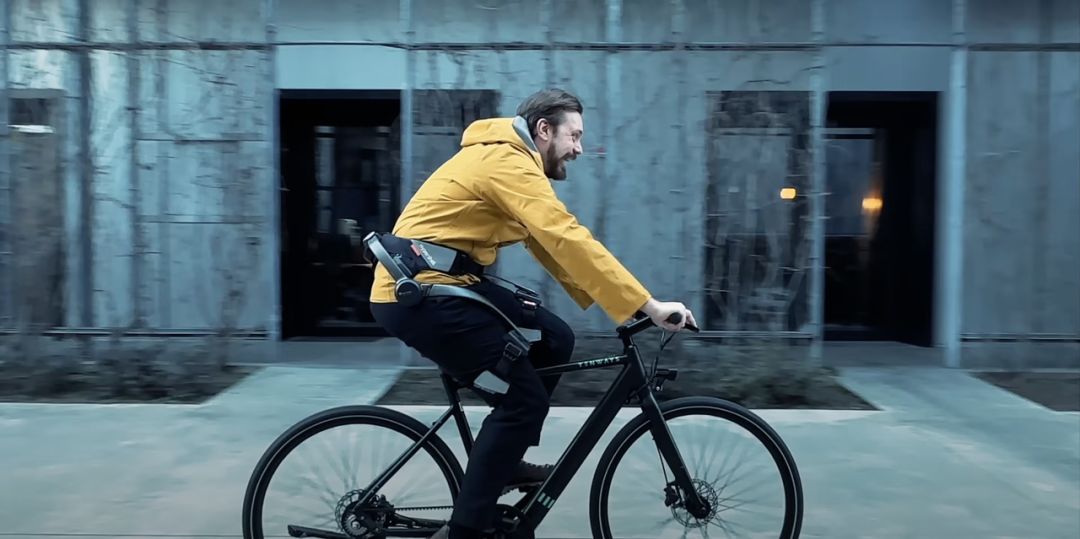
To date, the primary application scenarios for exoskeleton robots can be broadly classified into three categories.
The first is military scenarios. In recent years, military exoskeleton technology has become a crucial research direction to enhance the combat effectiveness of individual soldiers, aiming to bolster human physical function through physical assistance and reduce the burden of load, thereby extending combat time, improving efficiency, and enhancing survivability. The ExoM Up-Armoured exoskeleton armor from Germany's Mehler Protection is a recent achievement in this field. It utilizes the principle of load distribution and advanced mechanical design to effectively transmit the load to the ground, reducing the load by up to 70% and significantly minimizing the risk of muscle fatigue and sports injuries.
The second is medical scenarios. The application of exoskeleton technology in medical scenarios primarily focuses on neurorehabilitation and postoperative recovery, with the core service targets being patients with motor dysfunction caused by spinal cord injuries, strokes, or other neurological diseases. For example, Hocoma, founded in Switzerland in 2000, dominates China's high-end rehabilitation robot market. Its products aid individuals with brain diseases, spinal cord injuries, and degenerative motor function in physical recovery; products from Ekso Bionics in the United States can help paraplegic patients restore walking ability and even re-establish neuromuscular memory through brain electrical signals or mechanical feedback.
The third is industrial scenarios, primarily applied to physical laborers in automobile manufacturing, mining excavation, aircraft maintenance, etc., to alleviate muscle fatigue when carrying heavy loads, reduce the risk of work-related injuries, and enhance the efficiency of repetitive labor. For instance, Japan's Kawada Industries' "HYBRID POWER SUIT" can amplify human upper body strength by 5-10 times, making it effortless for workers to lift heavy objects.
However, exoskeleton robots primarily used in military and medical fields are costly. The price of a medical exoskeleton robot can reach 3 million RMB, far from achieving civilian popularization, which is why the term "exoskeleton" remains unfamiliar to ordinary people.
With the consumer market's pursuit of quality of life and the pressing need for auxiliary equipment in an aging society, exoskeleton robots have ushered in growth potential in the C-end market. Behind this trend, many exoskeleton companies are targeting scenarios such as elderly care and outdoor activities.
In fact, to expand professional tools into the consumer-grade product field, on the one hand, they must be functional in diverse scenarios/environments, and on the other hand, the degree of compatibility between the product and the human body must be sufficient. This necessitates consumer-grade products to be lightweight, easy to wear, durable, and reasonably priced. Simultaneously, it is crucial to enhance the adaptability of multiple sports scenarios at the level of motion control.
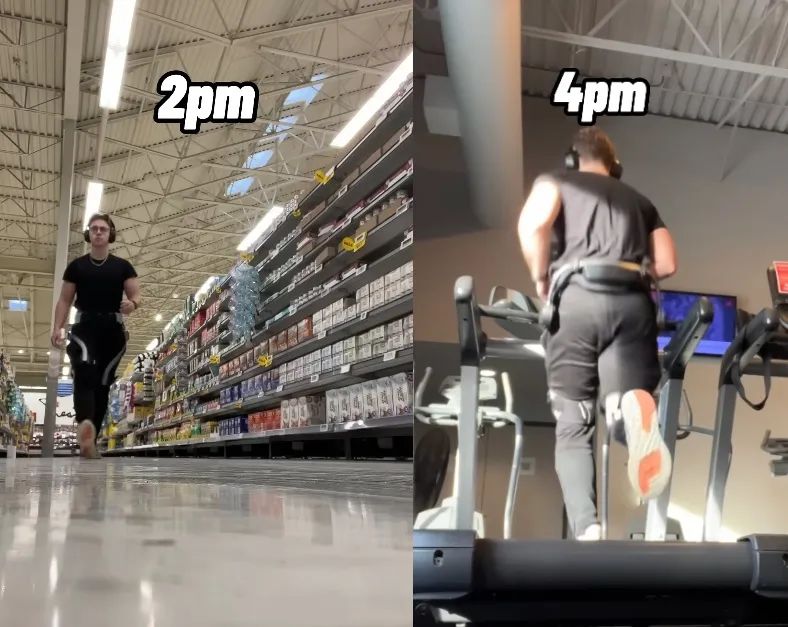
Currently, Hypershell Pro X offers 4 distinct assistance modes: "Comfort, Extreme, Transparent, Fitness," and 10 manually labeled motion states (6 for the basic version) or "Adaptive Motion Recognition" encompassing "Walking, Running, Uphill, Cycling," among others.
Hypershell's self-developed Hypershell Motion Engine (HME) adaptive system seamlessly integrates deep learning algorithms with real-time user motion data. Yu Zhipeng, co-founder and COO of Hypershell, shared with Xia Guang She that as users engage more frequently with the product and the user base expands, the HME system will continue to evolve through reinforcement learning, automatically iterating in various application scenarios, thereby demonstrating its intelligent compatibility. It is reported that after integrating Hypershell's proprietary AI system, Hypershell X enables users to seamlessly switch between 10 different scenarios, such as walking, running, mountain climbing, and even cycling, without pressing any buttons, and is constantly introducing new motion modes.
From the author's trial experience, the standout feature of Hypershell's product is its robust assistance. For instance, in the "Adaptive Motion Recognition" mode, users can distinctly feel their legs being "lifted up" when performing actions like uphill climbing or stair climbing. Some users have even shared with the author, "The Hyper mode is incredibly invigorating. After wearing it, 'Mom doesn't have to worry about me not liking to climb mountains anymore.'"
What sets Hypershell apart is its commitment to breaking the mold of traditional exoskeleton technology. For years, most exoskeletons have been designed for basic, repetitive tasks in workplaces or daily environments. However, Hypershell aims to bring mechanical legs into unpredictable and challenging wild environments, transcending simple single actions like short-distance flat walking. Instead, it aims to assist mountaineers in reaching summits, hikers in extending their trips, and trail runners in navigating rugged terrain more swiftly and smoothly.
Furthermore, to enhance competitiveness, the product's aesthetics and design are crucial tests. Intelligence, practicality, and aesthetics are indispensable, serving as prerequisites for market adoption.

In today's outdoor scenarios, lightweight is a core consideration for sports equipment, evidenced by products like carbon fiber hiking poles and GoPro, which highlight the trend towards lighter designs. As a new type of intelligent hardware, weight was a key factor Hypershell considered from the outset when targeting outdoor scenarios. Sun Kuan, founder and CEO of Jike Technology, once stated that this new exoskeleton enhances human athletic ability through electric assistance. The heavier the burden, the more assistance it provides, enabling a substantial one-time weight reduction. This makes it the preferred solution for users seeking lightweight and intelligent solutions in outdoor settings.
How did Hypershell create a product that is lightweight, intelligent, and suitable for wild environments? By independently developing its product architecture and core components.
In terms of configuration, Hypershell invented the world's first single-motor-driven exoskeleton system and officially launched the Omega architecture, based on a global patent, in 2023. This innovative configuration halves the cost and weight of the exoskeleton. For components, Hypershell independently developed core elements, such as high-power density motor modules specifically optimized for human-machine interaction, using high-strength lightweight materials like carbon fiber and titanium alloy to keep the overall weight, including the battery, at just 2.4 kilograms. These breakthroughs in core technology and structural design have also reduced Hypershell's cost to one-tenth of traditional products.
Leveraging a rich and agile Chinese supply chain system to control costs was also pivotal in Hypershell's creation of the world's first consumer-grade exoskeleton. "Our supply chain leader is always on the road, continuously working to reduce costs and refine the product," said Yu Zhipeng.
During the author's conversation with Hypershell, the pursuit of even greater lightweightness was confirmed. The company has ambitious goals for its products, aiming to halve their weight and volume in the future.
The innovation in structure and components directly enhances the product's comfort and ease of use. Yu Zhipeng shared with Xia Guang She a story about his father. "My father used to love climbing mountains, but as he aged, his physical strength declined. He didn't want the team to stop and wait for him, so he eventually had to give up climbing. After that, he had fewer opportunities to spend time with friends, and his mood wasn't as cheerful." Yu Zhipeng laughed, "After hearing about our product, my dad quickly asked me to get him a set too."
It is reported that Hypershell is actively exploring the Chinese market and plans to launch experiences and sales through the domestic trendy product channel DrivePro and its official website in August.
As an "emerging" product, discussions around exoskeletons are both curious and skeptical.
For example, some marathon races overseas already allow disabled athletes to wear mechanical exoskeletons to compete. Although this technology currently does not threaten top athletes' rankings, what will happen when records are threatened? Will marathon races reconsider the use of exoskeletons?
Sun Kuan addressed this issue in an interview: "For us, having athletes use this method to participate in marathons is also a way to test the effectiveness of the Hypershell product. An athlete running for a long time in an intense, competitive environment can see how truly effective this product is. It's not just about saving energy but also about helping athletes challenge their limits."
Undoubtedly, when new products enter the market, they inevitably face more "questions," requiring the market to spend more time evaluating the product to find its niche.
Yu Zhipeng believes that the path to market entry is crucial. He used the example of a robot vacuum cleaner: "I bought a robot vacuum cleaner over a decade ago. At that time, the product wasn't mature enough, which ruined my mother's initial impression of robot vacuum cleaners. Nowadays, after continuous iterations, robot vacuum cleaners have become much smarter and more convenient. However, that earlier impression may still affect her purchase decisions for a long time afterwards."

"The same applies to exoskeleton products. We don't want low-maturity products to give the market the impression that this category isn't viable," said Yu Zhipeng. In fact, from a market prospect perspective, the application market for consumer-grade exoskeleton robots is vast.
For instance, on Hypershell's backend, there's a user step count ranking. The team discovered that one person often tops the list, walking tens of thousands of steps daily. After contacting him, the team learned he's a Walmart employee whose daily job is to collect shopping carts from various locations. With the exoskeleton, he still walks the same distance but finds it much easier.
Another user, confined to his home due to leg weakness, could only walk to the supermarket in his community to shop after wearing Hypershell's product. It can assist in work, aid the disabled, and has the potential to assist the elderly. When worn by the elderly, the power device supports their lower limbs, helping them lift their legs, reducing muscle burden, and making walking and climbing stairs easier, thereby increasing their opportunities to go out. This makes exoskeleton-assisted robots emerge as a new type of "elderly care savior".
2025 is also known as the "first year of consumer-grade exoskeletons." It is predicted that by 2025, the market size of consumer-grade exoskeleton devices in China will exceed 5 billion yuan, with a compound annual growth rate of 45% in the medical rehabilitation field. Additionally, by 2030, the market size in the industrial field is expected to reach 12 billion yuan, and the market size in the outdoor sports field could reach 70 billion yuan.
Currently, in the domestic medical field, companies like Weisi Medical, Fourier, and Da'ai are leading the way, deeply cultivating the rehabilitation market for hemiplegic patients, with their products entering the medical insurance catalog. Chengtian Technology, driven by both the medical and consumer markets, is the world's first mass producer of consumer-grade exoskeletons. Haipuman Robotics, a subsidiary of Zhenjiang Co., Ltd., focuses on industrial exoskeleton research and development and has cooperated with Dongfeng Liuzhou Automobile on logistics handling, planning to mass-produce consumer-grade products by 2025. Toread and Maibao Intelligence have collaborated to develop lower extremity exoskeleton robots integrating multimodal sensors and intelligent algorithms, aiming for a fast response speed and a target sales volume of over 10,000 by 2025.
More relevant to the general public, this year, the application of exoskeleton robots in domestic tourist attractions has received positive feedback. According to staff at the Enshi Grand Canyon scenic area, after using exoskeleton robots, tourists' average mountain climbing time was shortened by 40%, and satisfaction increased by 90%. Besides scenic areas, Hypershell has also collaborated with the Blue Sky Rescue Team to apply exoskeleton robots in rescue scenarios.
Furthermore, Yu Zhipeng indicated that besides the current products applied to the legs, Hypershell has more possibilities, namely, multiple body parts may receive assistance from exoskeleton products. What is the future of exoskeletons? "The ultimate form of exoskeletons is Iron Man," said Yu Zhipeng.
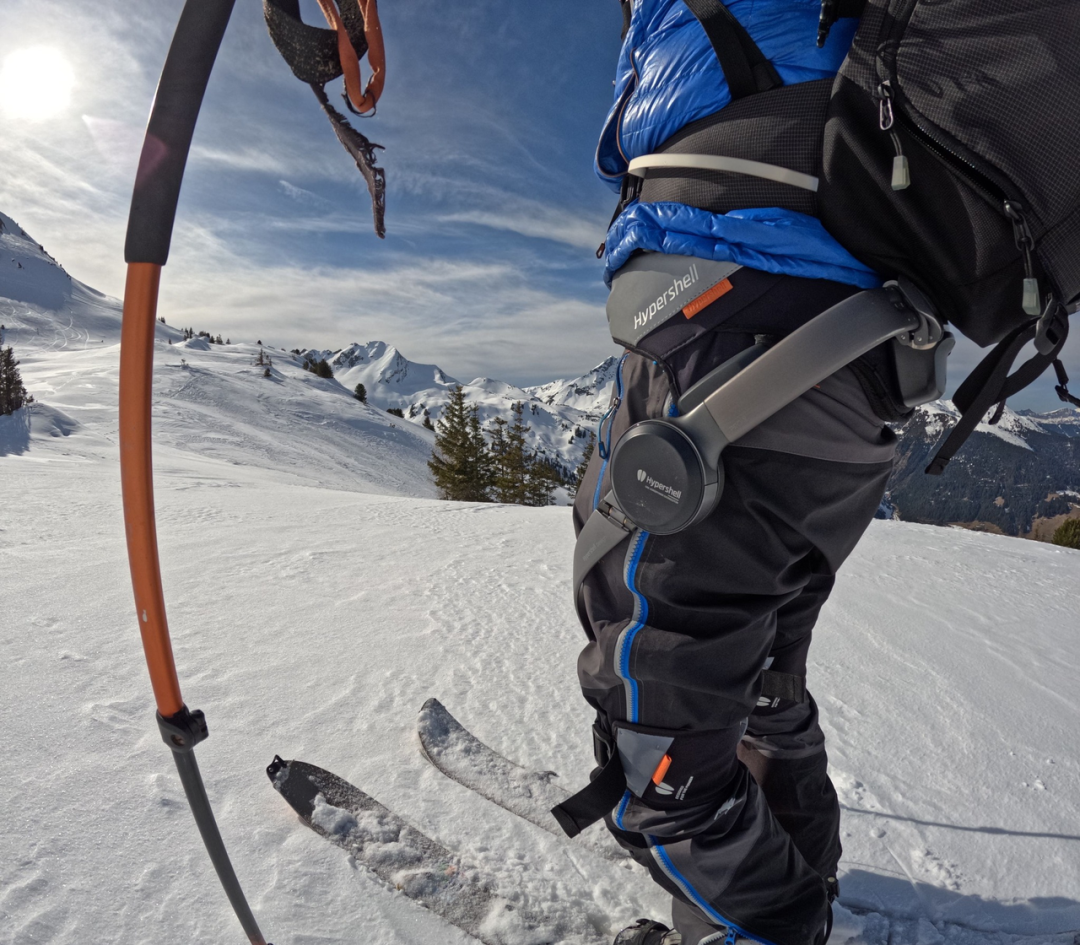
In recent years, due to increased market saturation and reduced product differentiation, innovating in intelligent hardware products seems to have become a struggle within the existing market. Where are the incremental and innovative points? A common view is that it's no longer about a single major product covering the entire market but rather targeting niche scenarios, capturing precise customer groups, conducting more detailed cultivation, and creating "top products" in niche fields. This may be a new approach for global brands of intelligent hardware.





